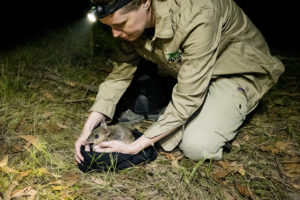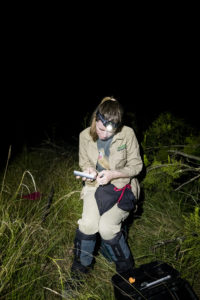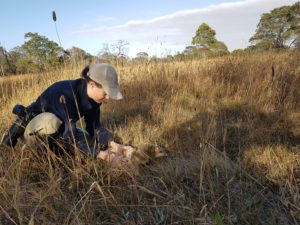
Dr Amy Coetsee
Threatened Species Biologist, Zoos Victoria
Field of expertise: Conservation, Eastern Barred Bandicoots
In the time you have been working in your field, what impossible things have become possible?
The key to saving Eastern Barred Bandicoots (EBBs) from the brink of extinction is to establish and protect them in areas that can be maintained fox free. Fifteen years ago when I joined the Eastern Barred Bandicoot Recovery Team there were probably only around 100 EBBs left on mainland Australia and our only solution to saving them from extinction was to release them into reserves surrounded by predator exclusion fencing, but our attention started to turn towards fox-free islands.
We don’t have many islands in Victoria that are fox-free and have suitable EBB habitat. Victoria’s largest island, French Island, stood out as a beacon of hope, but as EBBs had never been found on French Island before, it wasn’t easy to get community support. In fact, it looked impossible. Roll on 12 years, and EBBs were released on French Island, by the community, in October 2019. But this wasn’t the only island release that became possible in the last 12 years., EBBs were released on Churchill Island in 2015, and Phillip Island in 2017 after foxes were eradicated. There are now at least 500 EBBs on Victorian islands and with around 18,000 ha of suitable habitat, this number should increase.
What impossible thing(s) are you working towards making possible, and why?
For several years I’ve been trying to find a way to attach radio transmitters to bandicoots. These devices allow us to find things out about animals, like habitat preferences and where they sleep and find food. The longer transmitters stay attached, the more we can learn. Most animals seem to tolerate transmitters really well, but not EBBs, they seem to hate anything being stuck to them. They also have a triangular shaped head with no defined neck, which makes collars difficult to fit, unlike many other animals that can wear them easily.
For EBBs to tolerate a transmitter, it needs to weigh less than 5 grams, but lighter is always better. Many attachment techniques have been trialled over the years, including attaching them to their tails, the side of their body and between their shoulder blades, but all of them fall off, or are pulled off by the EBB pretty quickly, limiting the amount of data you can collect. I’ve had some success using collars on captive bandicoots, but to safely use them on free ranging bandicoots they need to have a weak link. This will allow a bandicoot to break the collar and free itself if its leg becomes stuck in the collar. So far I haven’t been able to figure out a reliable way to do this.
What is an example of an impossible thing others in your field are currently working to make possible?
Cameras are used widely these days as a hands off way to monitor wildlife. They allow us to catch moments that we wouldn’t normally see, like feral cats preying on wildlife, or females with their young. We can use the photos collected to calculate population densities of particular species and learn about their habitat preferences. In many ways, cameras are a great tool, but there is one problem with them. Too much data! One blade of grass moving in the wrong spot can result in thousands of photos (or false triggers) being taken. There currently isn’t a quick and reliable way to sort out the photos collected and identify any animals in them. Many people sort them manually, but this can take days, if not weeks. A lot of people are currently working on automating this process so that results can be obtained in a fraction of the time. This is no easy feat because we need to teach computers to identify different animals from different angles in different habitat types, this is especially tricky in Australia where many of our small mammals have a similar body shape. I’m looking forward to the day I can get a computer to quickly analyse my photos for me. Hopefully, that day isn’t too far away.
In your field are there any things that you predict will remain impossible, and why? 
I believe that nothing is impossible, there are just problems that haven’t been solved yet. One of these is the eradication of foxes and feral cats from mainland Australia. These introduced predators are responsible for many mammal extinctions in Australia and have pushed many more species to the brink of extinction. In areas where foxes and feral cats have been eradicated, such as fenced reserves and islands, our native wildlife flourishes. It would be wonderful to one day have a fox and feral cat free Australia, but at this stage that is unlikely to happen. For now, safe havens, such as reserves on mainland Australia surrounded by predator exclusion fencing and introduced predator free islands are our only hope of saving some species from extinction. Fox-free French Island where EBBs were released last year, is set to become an island safe haven, with plans underway to eradicate feral cats from the island. Threatened species such as, EBBs, Long Nosed Potoroos, Lewin’s Rail and Swamp Skinks will benefit from this eradication, and some that haven’t been seen on the island in decades, like the critically endangered Orange Bellied Parrot, may return.
In your opinion what formerly impossible and now possible thing in your field has made or is making the largest contribution to human or planetary flourishing?
Addressing climate change will make the largest contribution to human and planetary flourishing.
We’ve seen in Australia the impact climate change has on wildlife, with the devastating bush fires last summer, large numbers of flying foxes dying from heat exhaustion and the recent extinction of the Bramble Cay Melomys, which was the first species to go extinct due to climate change. Many species that are already on the edge of their range, like our alpine species will be pushed closer to extinction as our climate continues to warm.
It’s not just our wildlife that suffers with climate change, the impact on people will be huge. But it’s not all doom and gloom, we already have the technology and knowledge to halt and reverse climate change, what we need is to move away from burning fossil fuels and focus on renewable energy. In a country like Australia with boundless amounts of sun, there really isn’t any excuse to harness the sun’s energy, power Australia with solar, reduce energy bills and help save the planet.
 More information:
More information:
Zoos Victoria have many community conservation campaigns that you can get involved in. From blowing bubbles not balloons to protect our marine wildlife, to keeping your pet cat happy indoors (which protects your local wildlife too), and wiping for wildlife with recycled toilet paper, there are many ways you can help fight extinction. Check out this Zoos Victoria webpage for more information.
